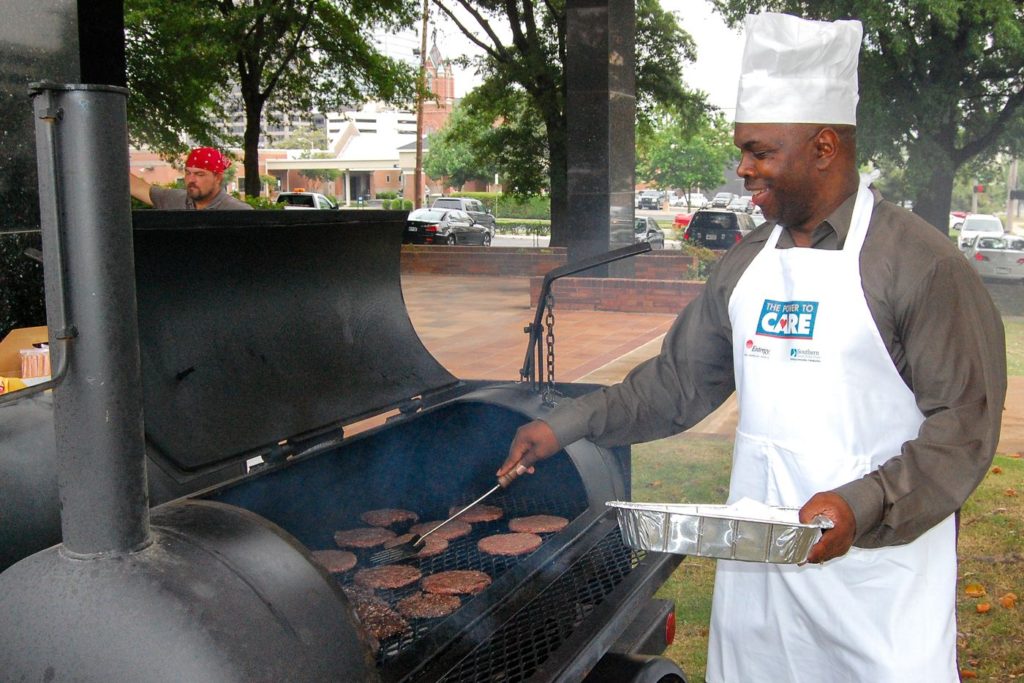Heart Attack at 49—America’s Biggest Killer Makes a Deadly Comeback
- July 16, 2019
- Kennedy Leverett
- No Comments
Younger people, women and nonsmokers are more likely to be victims of the crisis in cardiovascular health, driven by skyrocketing obesity and diabetes

PHOTO: ANDREA MORALES FOR THE WALL STREET JOURNAL
Author: Betsy McKay
One of America’s greatest achievements over much of the past century has been a huge decline in death rates from heart disease and strokes. Anti-smoking campaigns, medications to control blood pressure and cholesterol, and surgical advances have extended millions of lives, fundamentally reshaping the U.S. population.
Now, progress has stalled. That’s helping drive down life expectancy in the U.S. after decades in which each generation of Americans could expect to live longer than the one that came before.
The death rate for cardiovascular disease—which includes heart disease and strokes—has fallen just 4% since 2011 after dropping more than 70% over six decades, according to mortality statistics from the Centers for Disease Control and Prevention.
Particularly alarming is that the death rate is actually rising for middle-aged Americans.
The overall cardiovascular-disease death rate is an under-recognized contributor to the recent decline in U.S. life expectancy. While that has been driven mostly by deaths from drug overdoses and suicides, improvements in cardiovascular health are no longer providing a counterbalance.
Among victims are John Singleton, the 51-year-old filmmaker behind the movie “Boyz N The Hood,” and actor Luke Perry, the 52-year-old former star of “Beverly Hills, 90210.” Both died of strokes earlier this year.
Heart disease was once on course to fall below cancer as the nation’s leading cause of death, a change public-health statisticians most recently predicted would occur by 2020. No longer, said Robert Anderson, chief of the CDC’s mortality statistics branch. “It’s highly unlikely given the current trend that there will be a crossover anytime soon,” he said.
The obesity epidemic and related rise in the prevalence of Type 2 diabetes are key culprits in the new wave of cardiovascular disease mortality, researchers and cardiologists say. Studies have linked obesity and diabetes to high blood pressure and other conditions that increase the risk of heart attacks, strokes and heart failure.
“It’s a really major driver,” said Stephen Sidney, director of research clinics at the Kaiser Permanente Northern California Division of Research, who has studied the changes in cardiovascular disease mortality rates. Obesity began rising across the U.S. population in the early 1980s, and Type 2 diabetes rates accelerated several years later. That has given both “enough time to really impact in a negative way on the population,” Dr. Sidney said.

PHOTO: DUSTIN FRANZ FOR THE WALL STREET JOURNAL
Nearly 40% of U.S. adults age 20 and over are obese, another 32% are overweight, and 9.4% of U.S. adults 18 and over have diabetes, according to the CDC.
The consequences of obesity are eroding the enormous gains brought about by public-health campaigns against smoking, along with medical innovations such as cholesterol-lowering statin drugs. Statins, which were introduced starting in the late 1980s, have prevented millions of Americans from developing life-threatening blockages in their blood vessels that can cause heart attacks.
“You couldn’t see the effects of the obesity epidemic when we were in the process of getting people to use statins,” said Steven Nissen, chief academic officer of the Heart and Vascular Institute at the Cleveland Clinic. Now, he said, “we’ve got a counterforce here.”
Progress Stalls
*Includes heart disease and stroke. Source: Centers for Disease Control and Prevention
Oscar Washington Jr., just 49 years old, wasn’t feeling well when he got out of the shower one morning in April 2017 after a workout. “I think I got overheated,” the utility company vice president told his wife, Doris. He lay down on their bed.
His arm was hurting, and he started to twist and turn. Ms. Washington became worried. She wondered if he was having a heart attack. Mr. Washington’s father had passed away just four months earlier, of heart disease, and the couple was co-chairing a coming American Heart Association ball.
She gave her husband some aspirin and an ice pack. Then she helped him get dressed and drove him to the emergency room. Doctors there found him in the midst of a deadly heart attack, with blockages in a main artery on the heart and two others. Despite an emergency triple bypass operation, Mr. Washington died two weeks later of complications of his condition.

PHOTO: ANDREA MORALES FOR THE WALL STREET JOURNAL
Mr. Washington was an active member of his community who left behind a wife and two daughters. Hefty for his height, at 5 feet 6 inches and 250 pounds at the time of his heart attack, he had been on blood-pressure and cholesterol medications for years. But he worked out regularly and hadn’t been diagnosed with a heart condition, his wife said.
“He didn’t have any symptoms,” said Ms. Washington, a 52-year-old agriculture-agency official in Little Rock, Ark., who has managed her grief and loneliness by staying busy with work, caring for her daughters, now ages 20 and 13, and setting up a scholarship fund for Arkansas high-school students in her husband’s name.
Today’s heart-disease victim is vastly different from the classic patient doctors and the public were trained to recognize a half-century ago: a smoker, usually male, whose LDL, or “bad” cholesterol numbers were “sky high,” said Dr. Nissen. Now, the patients are younger, more obese, much less likely to be smokers and include more women, he said. Many are unaware that they are at risk.
Where Heart Disease Death Rates Are Rising
Death rates for people aged 55-64 are increasing in the south, where they are already high, and across the country, especially in rural and smaller metropolitan areas. Source: Centers for Disease Control and Prevention
“I’ve been working in a coronary-care unit for 40 years, and the patient that comes in now looks completely different from the patient when I was starting out,” he said. “It is an absolutely striking difference.”
He calculated the median BMI of patients in the unit one day recently. Obesity is defined as a BMI of 30 or above. The unit’s median was 34, he said. Several patients had BMIs over 40.
“I think obesity is the new smoking in terms of contribution to heart disease,” said Sadiya Khan, a cardiologist and assistant professor of medicine at Northwestern University Feinberg School of Medicine. “We’ve made such great progress in coming up with smoking-cessation programs. For physical activity, healthy diet and weight loss we haven’t found the right approach.”
Dr. Khan was lead author of a 2018 study in the journal JAMA Cardiology showing the lifetime risk of cardiovascular disease and deaths from it to be higher for overweight and obese adults than for people with a normal body-mass index. The researchers analyzed data from more than 190,000 participants in 10 study cohorts going back several decades.
Cardiovascular-disease death rates rose 1.5% between 2011 and 2017 for 45-to-64-year-olds, according to CDC statistics. That includes increases in the rates of deaths from strokes, hypertensive heart disease and heart failure—all diseases associated with obesity.

PHOTO: TIM GRUBER FOR THE WALL STREET JOURNAL
Older people still account for most cardiovascular deaths, but the cardiovascular-disease mortality rate for people 75 and older—who had benefited from the treatment advances and smoking cessation—actually fell 6% in the same years.
“I have seen 30-year-olds coming in with heart attacks,” said Robert Sanchez, medical director of cardiovascular medicine at HCA West Florida’s Northside Hospital and Tampa Bay Heart Institute. Over his 28-year career, he said, he has started to see younger patients. He also has more patients in their 90s, who have survived longer due to better health care.
The past success curbing cardiovascular deaths was hard-won. Heart disease and strokes were dreaded killers in the early- and mid-20th century. Scientists and doctors were only starting to understand the risks of smoking, high cholesterol and high blood pressure on the heart, and there were few treatments to prevent heart disease or save people.
The death rate fell steadily and sharply beginning in midcentury as public-health officials waged a war on smoking and exhorted people to eat more fruits and vegetables and to exercise. Medical advances such as coronary-artery-bypass surgery, defibrillators, better blood-pressure drugs and statins also saved lives.
The progress was so great that an editorial in the journal Science in 1996 posed the question, “Heart attacks: Gone with the century?”
But heart disease is still the nation’s top killer, and strokes, the other main component of cardiovascular disease, ranked fifth in the latest data.
Growing Risk for Hearts
Obesity and diabetes—factors that contribute to cardiovascular disease—have skyrocketed in the U.S. since the 1980s, and more people have uncontrolled high blood pressure. *Data are for people age 20 and older and are for two-year surveys ending in the year shown. Sources: Centers for Disease Control and Prevention (obesity, diabetes); American Heart Association (blood pressure)
Obesity and diabetes add to common risk factors such as high blood pressure that already made heart disease and stroke widespread. About 46% of American adults have high blood pressure, or hypertension, under guidelines released in 2017 by the American College of Cardiology and the American Heart Association. Of that group, three-quarters either aren’t being treated with medications or don’t have it under control, according to a study in Circulation, an AHA journal. High blood pressure can be caused by hereditary factors, too much sodium, excess weight and other factors.
he family of Mr. Singleton, the filmmaker, said after his death that he struggled with high blood pressure, a condition that often affects African-Americans earlier in life and more severely than people of other racial backgrounds in the U.S.
In obese people, excess weight leads to elevated blood pressure in several ways, including by increasing circulating blood volume and stiffening or narrowing blood vessels. The high blood pressure, in turn, puts strain on the heart and arteries, potentially leading to a heart attack. It can make blood vessels in the brain clog or burst, causing a stroke. It can also lead to heart failure.
People with obesity and diabetes also tend to have high triglycerides, a sign of poor metabolic health, a measure of factors such as blood sugar and blood pressure, and other metabolic abnormalities that are damaging to the heart and blood vessels. Abdominal fat produces proteins that drive inflammation, which research has shown to be linked to heart disease and stroke.

PHOTO: DUSTIN FRANZ FOR THE WALL STREET JOURNAL
Heart experts say they need new tools and approaches, because today’s cardiovascular disease patients differ from those of past decades, and they need to reach people young, before obesity and diabetes develop.
Researchers and doctors also need “more granular, more accurate, more timely” digital health-care data from multiple sources to verify and better understand the trend the mortality rates point to, said Harlan Krumholz, a Yale University cardiologist and health-care researcher. “We have to have great respect for the signal but need to be working to understand the signal,” he said.
Julie Kubala was at a movie with her husband when she developed a pounding headache and felt mild discomfort “in my breastbone.” She thought it was aftereffects of the flu that she was recovering from.

PHOTO: WASHINGTON FAMILY
The next morning, the pain was still there. She and her husband went to the emergency room. She was given an electrocardiogram, which showed she was having a heart attack. Doctors found an 80% blockage in her left anterior descending artery, a major pipeline of blood to the heart, and immediately placed a stent.
Ms. Kubala, who has obesity and Type 2 diabetes, was terrified from the experience, in March 2016. Until the heart attack, she had never spent a night in the hospital. “You have no idea what to do with this body now that it has betrayed you,” said the 51-year-old, who lives in Superior, Wis. “You realize that you don’t have the time that other people have.”
She attended a cardiac-rehabilitation program, and connected with other patients on an American Heart Association support network for help dealing with the trauma and fear of mortality that patients can develop in the aftermath of a heart attack. She is exercising more and watching what she eats.
Still, she said, “the battle continues.” Her blood sugar is higher than she wants it to be. The medications she is on make it hard to exercise intensely, and she spends long hours at a clerical job at a health clinic. “I can’t lose a pound to save my life,” she said.
Ms. Kubala said she is working to change a lifetime of habits that go back to being overweight in childhood and several years of jobs in fast-food establishments. Diabetes runs in her family but no one ever talked about the disease, risk factors, or dangers of burgers, fries and soda when she was growing up, she said. “I am of a generation that was never educated in any of that,” she said.

PHOTO: ANDREA MORALES FOR THE WALL STREET JOURNAL
